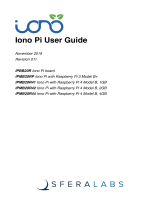
3Linux environment setup
3.1 Booting Raspberry Pi
To setup the Linux environment, first install and boot the Raspberry Pi with Raspberry Pi OS, as explained below:
Step 1
Download the latest Raspberry Pi OS image from https://www.raspberrypi.com, then choose Raspberry Pi OS
with desktop. For the tests below the version 2022-09-22-raspios-bullseye-armhf.img.xz (September 2022) has
been used.
Step 2
Unzip the Raspberry Pi OS image and write it onto the SD card by following the instructions available in the
section named “Writing an image to the SD card”.
Step 3
Connect the hardware:
• Connect the Raspberry Pi 4 to a monitor using a standard HDMI cable.
• Connect mouse and keyboard to Raspberry Pi’s USB ports.
It is also possible to work with Raspberry Pi using ssh. In this case. it is not required to connect the monitor,
keyboard and mouse with Raspberry Pi. The only requirement is to have the PC with ssh inside the same network
as the Raspberry Pi, and configure the IP address accordingly.
Step 4
Boot the Raspberry Pi 4 with an SD card. After booting, a Debian based Linux desktop appears on monitor.
Note: Sometimes, after booting Raspberry Pi OS, some keyboard keys do not work. To make them work, open the
file /etc/default/keyboard and set XKBLAYOUT=”us”, and reboot the Raspberry Pi.
3.2 Enable SPI on Raspberry Pi
The SPI driver inside the kernel communicates with the X-NUCLEO-NFC06A1/X-NUCLEO-NFC08A1 boards
through SPI. It is important to check if SPI is already enabled in the Raspbian Pi OS kernel configuration.
Check if /dev/spidev0.0 is visible in the Raspberry Pi environment. If it is not visible, enable the SPI interface
using the utility “raspi-config” by following the steps described below.
Step 1
Open a new terminal on the Raspberry Pi and run the command “raspi-config” as root:
sudo raspi-config
This step opens a graphical interface.
Step 2
Select in the graphical interface the option named “Interfacing Options”.
Step 3
This step lists various options.
Select the option named “SPI”.
A new window appears with following text:
“Would you like the SPI interface to be enabled?”
Step 4
Select <Yes> in this window to enable SPI.
UM2548
Linux environment setup
UM2548 - Rev 2 page 7/15



















